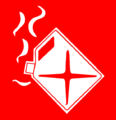Saponification is a process of cleaving esters into carboxylate salts and alcohols by the action of aqueous alkali. Typically aqueous sodium hydroxide solutions are used. It is an important type of alkaline hydrolysis. When the carboxylate is long chain, its salt is called a soap. The saponification of ethyl acetate gives sodium acetate and ethanol:
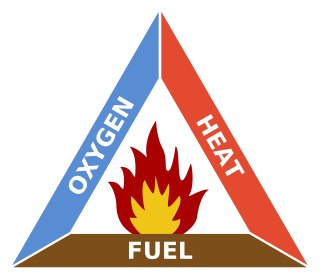
The fire triangle or combustion triangle is a simple model for understanding the necessary ingredients for most fires.

Fire safety is the set of practices intended to reduce destruction caused by fire. Fire safety measures include those that are intended to prevent the ignition of an uncontrolled fire and those that are used to limit the spread and impact of a fire.
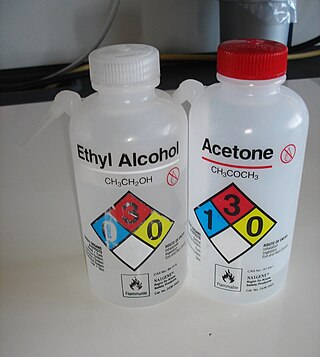
"NFPA 704: Standard System for the Identification of the Hazards of Materials for Emergency Response" is a standard maintained by the U.S.-based National Fire Protection Association. First "tentatively adopted as a guide" in 1960, and revised several times since then, it defines the "Safety Square" or "Fire Diamond" which is used to quickly and easily identify the risks posed by hazardous materials. This helps determine what, if any, special equipment should be used, procedures followed, or precautions taken during the initial stages of an emergency response. It is an internationally accepted safety standard, and is crucial while transporting chemicals.

Fire control is the practice of reducing the heat output of a fire, reducing the area over which the fire exists, or suppressing or extinguishing the fire by depriving it of fuel, oxygen, or heat. Fire prevention and control is the prevention, detection, and extinguishment of fires, including such secondary activities as research into the causes of fire, education of the public about fire hazards, and the maintenance and improvement of fire-fighting equipment.

A fire retardant is a substance that is used to slow down or stop the spread of fire or reduce its intensity. This is commonly accomplished by chemical reactions that reduce the flammability of fuels or delay their combustion. Fire retardants may also cool the fuel through physical action or endothermic chemical reactions. Fire retardants are available as powder, to be mixed with water, as fire-fighting foams and fire-retardant gels. Fire retardants are also available as coatings or sprays to be applied to an object.
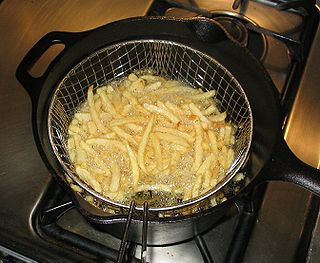
A chip pan is a deep-sided cooking pan used for deep-frying. Chip pans are named for their traditional use in frying chips.
Purple-K, also known as PKP, is a dry-chemical fire suppression agent used in some dry chemical fire extinguishers. It is the second most effective dry chemical in fighting class B fires after Monnex, and can be used against some energized electrical equipment fires. It has about 4–5 times more effectiveness against class B fires than carbon dioxide, and more than twice that of sodium bicarbonate. Some fire extinguishers are capable of operation in temperatures down to −54 °C or up to +49 °C. Dry chemical works by directly inhibiting the chemical chain reaction which forms one of the four sides of the fire tetrahedron. To a much smaller degree it also has a smothering effect by excluding oxygen from the fire. "Dry chemical" extinguishers, such as Purple-K, are different from "dry powder" extinguishers that are used to fight Class D flammable metal fires.
Mixtures of dispersed combustible materials and oxygen in the air will burn only if the fuel concentration lies within well-defined lower and upper bounds determined experimentally, referred to as flammability limits or explosive limits. Combustion can range in violence from deflagration through detonation.
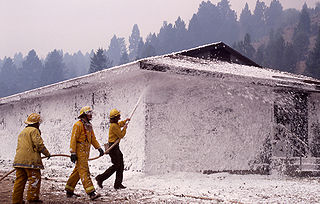
Firefighting foam is a foam used for fire suppression. Its role is to cool the fire and to coat the fuel, preventing its contact with oxygen, thus achieving suppression of the combustion. Firefighting foam was invented by the Russian engineer and chemist Aleksandr Loran in 1902.
Active fire protection (AFP) is an integral part of fire protection. AFP is characterized by items and/or systems, which require a certain amount of motion and response in order to work, contrary to passive fire protection.
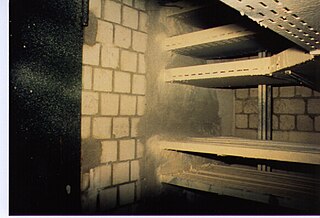
Passive fire protection (PFP) is components or systems of a building or structure that slows or impedes the spread of the effects of fire or smoke without system activation, and usually without movement. Examples of passive systems include floor-ceilings and roofs, fire doors, windows, and wall assemblies, fire-resistant coatings, and other fire and smoke control assemblies. Passive fire protection systems can include active components such as fire dampers.
A fire class is a system of categorizing fire with regard to the type of material and fuel for combustion. Class letters are often assigned to the different types of fire, but these differ between territories; there are separate standards for the United States, Europe, and Australia. The fire class is used to determine the types of extinguishing agents that can be used for that category.
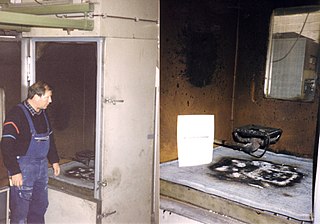
A combustible material is a material that can burn in air under certain conditions. A material is flammable if it ignites easily at ambient temperatures. In other words, a combustible material ignites with some effort and a flammable material catches fire immediately on exposure to flame.

Monoammonium phosphate, ABC Dry Chemical, ABC Powder, tri-class, or multi-purpose dry chemical is a dry chemical extinguishing agent used on class A, class B, and class C fires. It uses a specially fluidized and siliconized monoammonium phosphate powder. ABC dry chemical is usually a mix of monoammonium phosphate and ammonium sulfate, the former being the active component. The mix between the two agents is usually 40–60%, 60–40%, or 90–10% depending on local standards worldwide. The USGS uses a similar mixture, called Phos Chek G75F.
Commonly referred to as "Fast Flow" or "High Performance" extinguishers. Available in 6 kg (13 lb), 9 kg (20 lb), and 14 kg (30 lb). capacities and contain ABC Dry Chemical, Purple-K, or sodium bicarbonate. They are currently manufactured by Ansul in cartridge-operated form, along with Amerex, Badger and Buckeye stored pressure design.

A fire extinguisher is a handheld active fire protection device usually filled with a dry or wet chemical used to extinguish or control small fires, often in emergencies. It is not intended for use on an out-of-control fire, such as one which has reached the ceiling, endangers the user, or otherwise requires the equipment, personnel, resources or expertise of a fire brigade. Typically, a fire extinguisher consists of a hand-held cylindrical pressure vessel containing an agent that can be discharged to extinguish a fire. Fire extinguishers manufactured with non-cylindrical pressure vessels also exist but are less common.
Home safety is the awareness of risks and potential dangers in and around a home that may cause bodily harm, injury, or even death to those living there.

Condensed aerosol fire suppression is a particle-based method of fire extinction. It is similar to but not identical to dry chemical fire extinction methods, using an innovative pyrogenic, condensed aerosol fire suppressant. It is a highly effective fire suppression method for class A, B, C, E and F. Some aerosol-generating compounds produce a corrosive by-product that may damage electronic equipment, although later generations lower the effect.
In fire and explosion prevention engineering, inerting refers to the introduction of an inert (non-combustible) gas into a closed system to make a flammable atmosphere oxygen deficient and non-ignitable.


